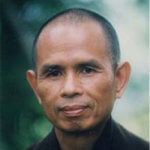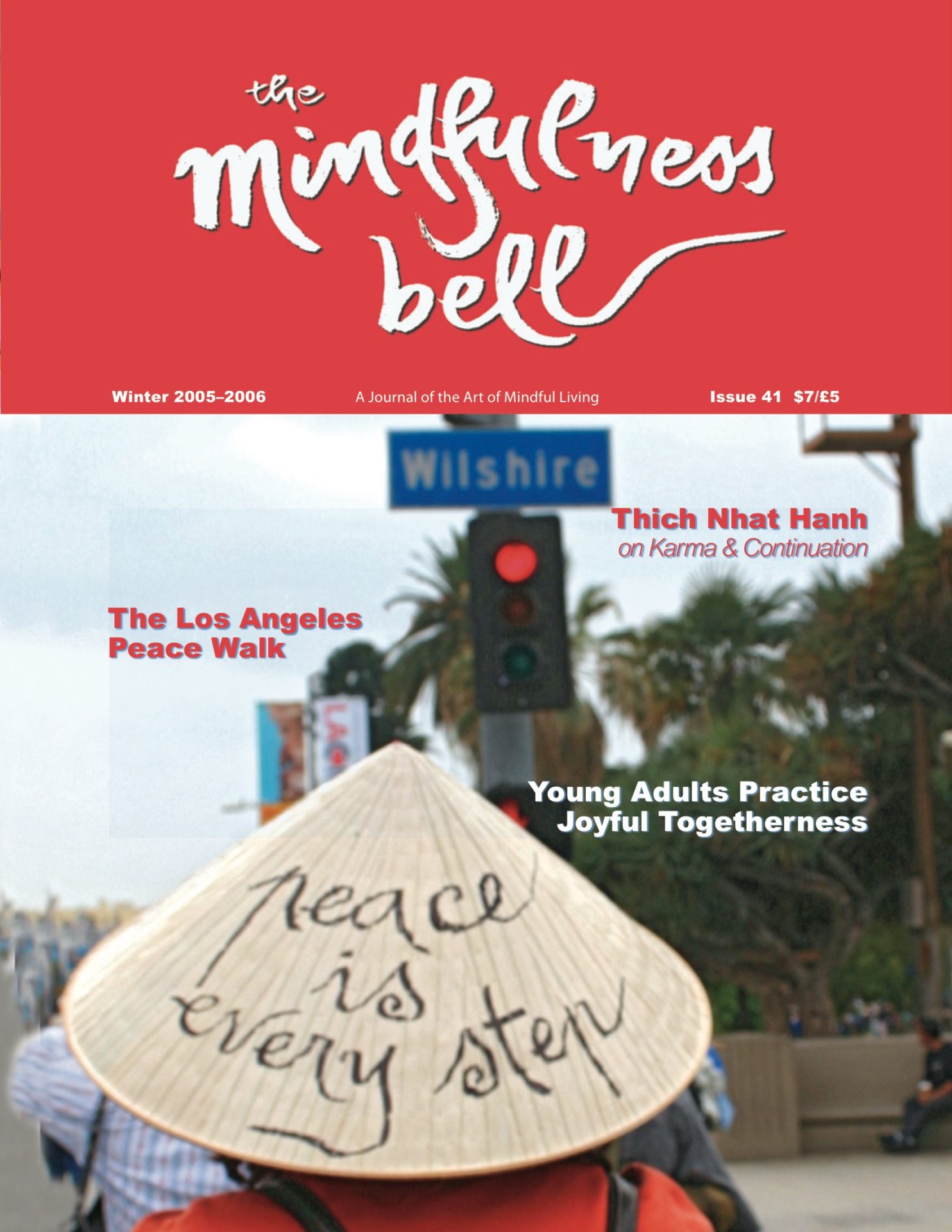Good morning, dear friends. Today is August 5, 2005. We’re in the Upper Hamlet of Plum Village on the last day of our summer session.
Today I would like to speak about reincarnation, rebirth, and continuation. If we look at an orange tree we can see that it makes an effort every day to have a long continuation. Every day the orange tree makes leaves, and in the spring it makes orange flowers,
Good morning, dear friends. Today is August 5, 2005. We’re in the Upper Hamlet of Plum Village on the last day of our summer session.
Today I would like to speak about reincarnation, rebirth, and continuation. If we look at an orange tree we can see that it makes an effort every day to have a long continuation. Every day the orange tree makes leaves, and in the spring it makes orange flowers, which become tiny oranges. In those oranges are seeds, and that is how the orange tree assures its continuation. The orange tree has to continue.
And we do, too. We are humans and it is a natural tendency to prepare ourselves to continue. So continuation, rebirth, reincarnation is normal. How do we continue ourselves? This question begins our meditation together. Every time you produce a thought, that thought is a continuation. That thought will have effects on us, on our body, our mind, and on the world. The effect of that thought is our continuation. Producing a thought is the cause; the effect is how that thought impacts us and the world.
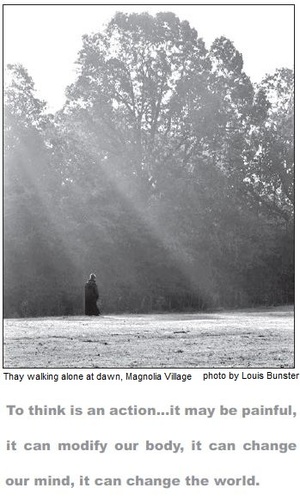
To think is an action. Because the thought may be very strong, it may be painful, it can modify our body, it can change our mind, it can change the world. So thought is a form of action.
In Buddhism we use the word karma. Karma is action, action as cause and action as fruit. When action is a cause, we call it karmahetu. The Chinese word for karmahetu contains the character for karma and a character that means “seed.” When we produce a thought, the production of the thought is a karmahetu, karma-cause. That thought will have an effect on our mental and physical health and on the health of the world. And that health, good or bad, is the fruit of the karma, the fruit of the thought. Karmaphala is the karma-fruit. So karma is action, action in the cause and action in the fruit.
Right Thinking
When we produce a thought, we have to ensure that the thought is a good thought, a right thought, because if it is, it will bring us physical and mental health, and it will help the world to heal itself. Our practice is to try to live in such a way that every day we produce only good thoughts, thoughts in the direction of right thinking. We have to train ourselves to do that. A bad thought can destroy the physical and moral health of ourselves and of the world. So we have to be careful to produce only good thoughts.
Right thinking is recommended to all of us by the Buddha. It’s action in the form of thought. Each time we produce a thought, that thought carries our signature. You cannot say, “No, I didn’t produce that thought.” That is karma. Karma-cause, karma-fruit. If it is a cause, it will lead to a fruit—the fruit will be bitter or the fruit will be sweet, depending on the nature of the karma.
Right Speech
First, we have to understand that thinking is action. When we say some thing, that speech will have an effect on our body, on our mind, and on the world. Good speech will give us joy and health — physical and moral health — and it will change the world in the direction of goodness. We should produce right speech, which inspires understanding, joy, hope, brotherhood, and sisterhood. Your speech is the seed, it is the cause. And what it produces in you and in the world is the karmaphala, the karma-fruit. Action as cause and action as fruit.
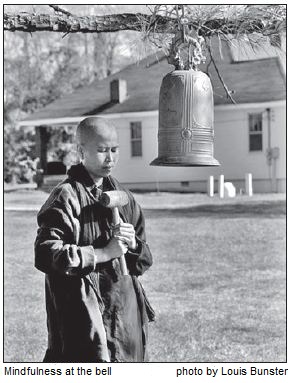
Sometimes action-fruit manifests immediately after the action-cause. Sometimes it takes months or years before it leads to a result, but sooner or later the cause must become the effect.
Right Action
The third kind of action is the physical act, the act carried out by the body. With the body you can do things. You can kill a person, you can kill an animal, you can kill a tree. You can save a person, you can save an animal, you can save a tree. The Buddha recommends right action because the action will have an effect on your physical and moral health as well as the world’s. We have to ensure that our actions are in the direction of right action.
Jean-Paul Sartre was a philosopher in the existential tradition. He said that man is the sum of his actions. When a child is born, he hasn’t acted yet, so he cannot be defined. But as the man begins to act, we can look at his actions and see the man. Man is defined by his acts. What Jean-Paul Sartre said is very close to Buddhism.
But Sartre’s declaration was not detailed enough, because we need to include thoughts. Our speech comes from what we are thinking; thinking is at the base of all speech and of all action. We may say that man is the sum of his thoughts, his words, and his acts. I think that Jean-Paul Sartre would agree, because in using the word “acts” he meant to include thinking and speech. Thinking as action, speech as action.
Thoughts, speech, and action create karma, and we produce this energy every moment of our daily life. You continue to say things, you continue to do things, and every thought, every word, every act of yours carries your signature. And that is your continuation. It is never lost.
The scientist Lavoisier, said, “Nothing is lost.” He’s a Buddhist, essentially. Nothing is created, nothing is lost. What you have produced as thoughts, as speech, as acts, continues to influence the world, and that is your continuation. Your continuation is your rebirth and your reincarnation. Nothing is lost. So you have to ensure a good future, a good continuation.
We want to continue in beauty. And we know that in order to continue in beauty we have to ensure that our thoughts are right thoughts, our speech is right speech, and our acts are right action. These are three branches of the Noble Eightfold Path recommended by the Buddha.
Right View
What is right view? Right view is our way of understanding the world; it brings insight into the ultimate reality. We are so often the victims of wrong views, and based on wrong views we create suffering for ourselves and others. So we have to avoid wrong views, wrong perceptions. If we continue to suffer because of violence and terrorism, it is because we need right view. The terrorists have a wrong view of themselves and of others, and the anti-terrorists also have wrong views about themselves and about the terrorists. Based on wrong views, we keep killing each other, so we have to look more deeply to obtain right view. With right view we will be able to stop the violence and terrorism. Right view is the basis of all right thinking, right speech, and right action, and that is why the Buddha began with right view.
The Buddha describes right view in a precise, deep, and clear way. A right view reflects wisdom, the nature of existence.
Impermanence
For example, the Buddha spoke of the impermanence of things, of phenomena, and other wise men have also spoken of this. For example, Heraclitus said that you can never step into the same river twice, because the river is constantly changing. It is a fact that everything changes. Right view goes in tandem with the insight of impermanence. A view that is not based on impermanence is a wrong view. When we have right view we don’t suffer, and we can create happiness.
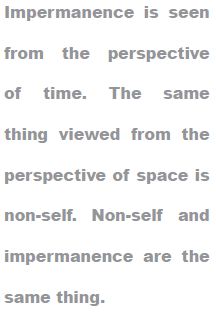
This is not just philosophy, it is life. For example, when you have difficulties with your partner, and you are about to argue with each other, the Buddha would say to you, “Dear friends, close your eyes. Imagine your beloved in three hundred years. What will she become?” When you can see what happens three hundred years from now, you see that it’s not wise to argue, because life is impermanent. If you can touch impermanence, when you open your eyes you will no longer be angry. You’re saved, because of the insight of impermanence.
Intellectually, maybe you agree that things are impermanent, but in your practical life, you act as if things are permanent. The Buddha does not speak of impermanence as a philosophy, but as a practice. We should practice concentration on impermanence. For example, all day, when you look, when you listen to something, you should get in touch with the insight on impermanence.
Looking at a flower, you see that it is impermanent. Looking at a person, you see that he or she is impermanent. So the insight on impermanence stays with us all the time, and that is why it is not a theory, but a concentration. It is the concentration on impermanence that will save you, and not the idea of impermanence.
With mindfulness we can keep the insight on impermanence alive and that will protect us from producing wrong thinking or wrong speech. So right view is the view that contains the nature of impermanence.
Non-self
We imagine that every person has a separate soul that remains the same forever, even as the body ages and decomposes. This is a wrong view, because it goes against the truth of impermanence. Nothing stays the same for two consecutive moments. So if we accept the reality of impermanence, we have to also accept the truth of non-self.
Impermanence is seen from the perspective of time. The same thing viewed from the perspective of space is non-self. Non-self and impermanence are the same thing.
When the son sees the father as a different person, as someone who has caused a lot of suffering and difficulty for him, he wants to punish his father with his words and actions. He doesn’t know that to make his dad suffer is to make himself suffer at the same time. You need to understand that you and your dad share the same reality. You are the continuation of your dad. If your dad suffers, you will also suffer, and if you can help your dad not to suffer, then your happiness will be possible. With the insight of non-self we can avoid many mistakes, because non-self translates into right view.
Terrorists and anti-terrorists think of themselves as two different entities. The anti-terrorist says, “We must punish the terrorist, we have to eliminate him.” And the terrorist also thinks that the other person is the cause of the suffering in the world, and in order to survive, he has to be eliminated. They don’t know that they are the same.
All the parties in a conflict have to understand the insight of non-self. If the other side continues to suffer, if there’s no safety, peace, or understanding on the other side, there won’t be safety, peace, or understanding on our side. When both sides realize that they inter-are, when they touch the nature of non-self, then there will be right view. With right view we will think, speak, and act in the right way, and then safety can become a reality. Right view is a view of reality that translates into impermanence, non-self, and interbeing.
Interbeing
When we look deeply into a flower we see the elements that have come together to allow it to manifest. We can see clouds, manifesting as rain. Without the rain, nothing can grow. So when I touch the flower, I’m touching the cloud, touching the rain. This is not just poetry, it’s reality. If we take the clouds and the rain out of the flower, the flower will not be there. With the eye of the Buddha, we see the clouds and the rain in the flower. And we can touch the sun, without burning our fingers. Without the sun nothing can grow, so we cannot take the sun out of the flower. The flower cannot be separate; it has to inter-be with the light, with the clouds, with the rain. The word “interbeing” is closer to reality than the word “being.” Being really means interbeing.
The same is true for me, for you, and for the Buddha. The Buddha has to inter-be with everything. Interbeing and non-self are the objects of our contemplation. We have to train ourselves so that in our daily life we can touch the truth of interbeing, of non-self in every moment. You are in touch with the clouds, with the rain, with the children, with the trees, with the rivers, and that contact reveals the true nature of reality, the nature of impermanence, the nature of interbeing, of non-self, of interdependence. If you can touch reality like that, you will have right view. And when you have right view, all your thoughts will be right, all your words will be right, and all your actions will be right.
This is why cultivating right view is the basis of the practice of Buddhism. And we can practice as an individual, as a community, as a city, as a nation. If we are shut in the prison of permanence, of self, we cannot obtain right view. In order to cultivate right view, we have to have concentration. We have plenty of intelligence to understand the notions of impermanence and non-self but the notions do not help us. That’s why we have to train ourselves to see things in their true nature. We have to keep this insight alive in every moment. That is why concentration is very important.
Right Concentration
The Sanskrit word for right concentration is samadhi. The notions of impermanence and non-self are useful, but they are not powerful enough to liberate you, to give you a right view. So you have to have concentration. Samadhi prajna is right view, insight, which is at the basis of all right thinking, right speech, and right action. But to cultivate prajna we have to practice concentration. We have to live in concentration, to touch deeply into things in every moment. We live deeply when we can see the nature of impermanence, of non-self, and of interbeing in the flower, and we can do this thanks to the practice of concentration. Without samadhi there is no prajna, there is no insight. So concentration is a door that opens onto the ultimate reality. It gives us right view.
Right Mindfulness
But before we can have concentration, we have to cultivate mindfulness. Mindfulness is smrti.
Mindfulness is the energy that can help us bring the mind back to the body so that we can establish ourselves in the present moment. In that way we can look at the blue sky. We can look at the clouds. We can look at the child who is sitting in front of us. And we touch deeply the wonders of life. That’s mindfulness.

Mindfulness is the capacity of recognizing what is happening in the present moment. When pain manifests, we will be able to embrace that pain, in order to transform it. With strong mindfulness, we can realize the Kingdom of God is available, and the joy of living is possible.
Andre Gide said that God is happiness. I like that. And he said, “God is available twenty-four hours a day.” I also agree with him on that. If God is available twenty-four hours a day, then His kingdom is also available. The only question is whether we are available for the Kingdom of God, available for happiness. Mindfulness makes us available to the Kingdom of God, to the wonders of life that are here, in the present moment. I know there are many Buddhists in France, including Jean-Paul Sartre and Andre Gide, and the scientist Lavoisier.
Mindfulness is what we practice in Plum Village. We walk in such a way that every step produces mindfulness. When we breathe, when we wash our hands, when we cook, we do all that in mindfulness. Generating the energy of mindfulness is the basic practice because mindfulness is the carrier, the bringer of concentration.
When you are mindful of something, you are concentrated. The energy of concentration is in the mindfulness. As you continue, that concentration will become stronger and stronger. With vigorous concentration you can make a breakthrough into reality, and then you can touch impermanence as a reality. You can touch interbeing, non-self.
The Buddha began with right view, but I would like to begin with mindfulness.
Right Livelihood
Then we have right livelihood, our work, our job. The Five Mindfulness Trainings instruct us to choose a livelihood that will help us produce right thoughts, right words, and right actions. Unfortunately, there are kinds of work that harm us, that harm the environment, that bring violence. We have to look with mindfulness, to see what kind of work to have, so that we will be able to practice right thinking, right speech, and right action in our work.
Schoolteachers can practice in such a way that their thoughts, their words, and their actions nourish their students every moment of the day. The children in their class may have a lot of suffering. Perhaps their parents have not offered them enough of the appropriate kinds of food. They have not had the chance to receive right thinking, right speech, and right actions, and they’ve been wounded.
As a teacher, you look at the child and you see the suffering. And you know with right thinking, right speech, and right action you will be able to heal the child’s wounds. You have the ability to give that child a second chance by playing the role of the dad, the mom, for the child. The class can become a family. If you’re a doctor or a therapist, you can do the same thing. If you have understanding and compassion, you have a lot of power because when people come to you, your right thoughts will help heal people. You can help them because you have healed yourself by developing the energy of understanding and compassion.
The Buddha spoke of right livelihood, not only for monks and nuns, but for everyone. Right livelihood helps you produce right thinking and right speech. We need to take the time to look at our work, to see whether it supports us in producing right thinking and right speech every day.
Good thoughts always go with understanding and love. An occupation that causes you to produce thoughts of anger and of discrimination is not good for your health or for the health of the world. You may have to accept another form of work with a lower salary that will give you the chance to generate good thoughts and good speech. It’s possible to live in a healthier, happier way. If you have right view, you will have enough courage to stop the course of violence and of attachment. So right livelihood is very important, and we can define this in terms of right thinking, right speech, and right action.
Right Effort
The eighth is right diligence, right effort. The Buddha taught how to cultivate and take care of our energy, and he also taught how to practice conserving energy. In Buddhist psychology, we see our consciousness as having two layers. The lower layer is called the store. It’s always operating, even in our sleep. The store receives information and classifies it, and it makes a lot of decisions without the intervention of the mind consciousness, which is the upper layer.
When you drive a car you think it’s the mind consciousness that is driving, but actually a large part of the work is done by the store, without our conscious thinking. When you do your everyday work, the store plays an important role.
When the store operates, it takes less metabolic energy than the mind does. The mind consciousness takes a lot more sugar, glycogen, and protein to work. At the level of the store things are done very quickly and inexpensively, so most things are handled by the store and the mind consciousness does just the final part. In the store many seeds are buried, good seeds and bad seeds. The seed of anger is there. The seed of despair is there. The seed of meanness, the seed of compassion, are there. The seed of joy is there. So to cultivate right effort the Buddha proposed four practices.
Four Practices for Cultivating Right Effort
The first practice is, don’t water the bad seeds. You know that there are negative seeds in you, and if they manifest, you will suffer. So let them sleep peacefully. When you watch a film, when you read a newspaper, when you listen to music, there is a chance that a seed will be watered and will manifest. We have to consume in mindfulness so that the bad seeds are not watered. When we love each other we have to sign a peace treaty. “Darling, I promise never to water the bad seeds in you or in me, and you have to do the same. You have those seeds. You must not water them in you, and don’t water them in me.”
The second practice is that every time a bad mental formation manifests, we have to make it go back to sleep, because if we keep it here too long, then it strengthens down in the base. If we leave it up in the mind for an hour, then that seed has an hour of strengthening. It’s dangerous.
The third practice is to allow the good seeds to be watered so they have a chance to manifest in the mind. For example, a Dharma talk is a kind of rain that can water the good seeds in you. When they manifest in the mind consciousness, the landscape will be much more beautiful.
The fourth practice is when the good seed has already manifested, we help it to stay in the mind consciousness as long as possible. Like when you have a friend who comes to visit bringing good news, you try to keep that friend with you as long as possible.
That is the teaching of the Buddha on right effort, diligence, and conserving energy. It’s very concrete and practical and is done in a natural, relaxed way. We don’t need to fight or struggle; we don’t have to make exhausting efforts. Naturally and with a lot of pleasure, we can enjoy the practice.
These are the eight right practices representing the Noble Eightfold Path proposed by the Buddha to all of us. If a teaching can reveal the Noble Path, it is an authentic teaching of the Buddha.
The Right View of Reincarnation
Continuation is happening now, because every day you continue to produce thoughts, words, and actions that carry your signature. We don’t have to wait until this body decomposes to continue.
Most people think of reincarnation in terms of a permanent soul. This is popular Buddhism. But we have to rise to the level of right view. Continuation is a necessity, it is a truth. But this continuation must be seen in the light of non-self, of impermanence.
If, for example, you want to recognize my continuation, do not look in this direction. [Thay points to himself.] There is a part of my continuation in this direction, but when you look all around you, you will see other forms of the continuation. So don’t wait for the body to decompose. We’ve already begun our continuation. You know that you have the power to change. You can ensure a beautiful continuation. Let’s suppose that yesterday you produced a thought that was not worthy of you, and today you’re sorry. You think, “I don’t want to be continued in that way.” You can correct it, you can transform that continuation.
If you have touched right view, you will be able to produce a different thought, a thought that is worthy of you today, a thought that carries within it understanding, compassion, and nondiscrimination. The moment you produce this wonderful thought, it will go out and catch the other thought that you produced yesterday. And in the space of half a second it will be able to transform that thought.
So you have the chance to correct the past; this is wonderful. We say that the past is already gone, but the past is always returning with its new manifestations, and with those manifestations we can correct it.
If you have said something that’s not worthy of you, say something else today, and that will transform everything. Do something different today based on right view and transform the whole situation. That is possible.
If you have a Sangha that supports you, if you are supported by the collective right view, then it’s very easy to produce such thoughts, such words, such actions, to transform everything right now, today, to ensure a good future, a good continuation.
The teaching of the Buddha is very deep, and at the same time very practical. This teaching has the capacity to heal us, to transform our pain, our fear. It’s good to have enough time to learn more about these teachings and put them into practice in our daily life.
Translated from the French by Sr. Pine Tree.
Transcribed by Greg Sever.
Edited by Barbara Casey and Janelle Combelic.
To request permission to reprint this article, either online or in print, contact the Mindfulness Bell at editor@mindfulnessbell.org.
